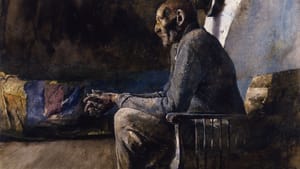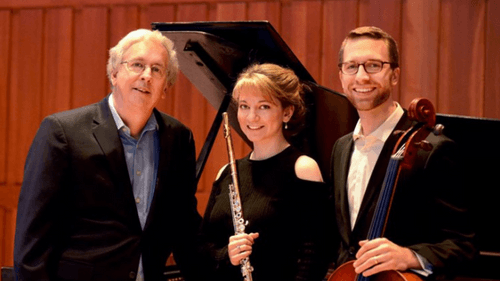Stay in the Loop
BSR publishes on a weekly schedule, with an email newsletter every Wednesday and Thursday morning. There’s no paywall, and subscribing is always free.
Music makes art make music
Dolce Suono Trio at the Brandywine River Museum of Art

The works of Andrew Wyeth will soon leave the Brandywine River Museum, but on September 9, the exhibition generated one more burst of inspiration. Dolce Suono Trio — Mimi Stillman (flute), Nathan Vickery (cello), and Charles Abramovic (piano) — swapped Philadelphia for the bucolic Brandywine countryside and gave a vivid, eclectic concert set amid art and trees.
Modern and classic
Playing in the museum’s whitewashed second-floor circular atrium, an austere setting with surprisingly receptive acoustics, the trio opened their ekphrastic concert with the romantic allegro maestoso movement of Sibelius’s “Hafträsk” Piano Trio. Stillman (who arranged the work) noted that they chose it as an opener because N.C. Wyeth — Andrew’s father — often listened to Sibelius in his studio as he painted.
The evening’s artful repertoire juxtaposed modern and classic works, all united by their connections with visual art. Sibelius was followed by “Spirit Island,” a two-movement work on a four-note theme by Philadelphia composer Andrea Clearfield. The work’s fluid structure evokes water, alternately rising out of Debussy-like chords, then sliding into the 21st century on waves of thoughtful dissonance.
The trio then played “Three Watercolors” by Philippe Gaubert (1879-1941), an important flutist and pedagogue whose warm-up exercises are still part of Stillman’s artistic practice. The composer also conducted the Paris Opera, giving him an affinity for storytelling evident in this tribute to genre painting of the era. It’s an accomplished and graceful piece, as was the authoritative rendering the trio afforded it.
The second half of the evening opened by featuring each instrumentalist (playing from memory) and Abramovic in back-to-back duos. Vickery gave Dvořák’s haunting “Waldesruhe (Silent Woods)” a technically and emotionally impeccable reading. Transcribed by the composer, the piece was originally written for piano four-hands, and Abramovic’s evocative keyboard work was especially beautiful here. The composer’s affection for the cello was affirmed at the work’s close, when Vickery raised his instrument in tribute and acknowledged his own ample ovation.

The concert then highlighted another work meaningful to the performer, Debussy’s “Prélude à l’après-midi d’un faune (Prelude to the Afternoon of a Faun).” In a beautiful arrangement by French composer Gustave Samazeuilh, a contemporary of Debussy, Stillman captured the haunting quality of this work originally scored for orchestra. Embracing its limpid romanticism, she also gave it a spine of deep longing that created unexpected tension.
A trio for the trio
The centerpiece of an evening filled with terrific music was Jennifer Higdon’s 2015 “American Canvas.” Commissioned by the trio, this piece, like the Gaubert, has three varied and painterly movements. In her work, the Philadelphia composer (also a flute player who grew up among visual artists) pays tribute to three American painters.
The first movement — filled with layered, dramatic interlacing lines for flute and cello — evokes the works of Georgia O’Keefe. It’s followed by a vibrating, virtuosic recreation of a Jackson Pollock painting. The keyboard ostinato provides a throbbing continuo that grounds the instrumental filigree in a dramatic illustration not only of the painter but also of the trio’s exceptional ensemble work.
Higdon’s third movement is a tribute to her “favorite artist,” Andrew Wyeth; she visited the museum while writing the work. As its start, Abramovic reached inside the piano case to play its strings, and the plucked notes made layers of sound evoking the painstaking process of Wyeth’s tempera technique. She also wrote fluid lines mimicking the wash of watercolor, another medium for which the painter is celebrated. (The trio just recorded this work, and it will soon be released along with the Clearfield.)
The evening ended by celebrating another centenary, Leonard Bernstein’s, with an upbeat set of three songs from West Side Story. The trio had the audience snapping along with “Cool” and sighing through a luscious rendition of “Maria.” They ended with the jazzy “America,” and Abramovic, who arranged the work, wrote a great piano part and played it with gusto.
The trio is part of the larger Dolce Suono Ensemble, founded in 2005 by Curtis alum and artistic director Stillman. The group has won accolades worldwide, and Higdon’s “American Canvas” was part of the ensemble’s active commissioning program (50 world premieres in 12 seasons). This well-constructed concert was an opportunity to hear their musical artistry in an intimate setting, a reminder of the deep connections between the aural and visual arts.
What, When, Where
Dolce Suono Trio. Jean Sibelius, "Hafträsk" Piano Trio in A Minor ; Andrea Clearfield, "Spirit Island"; Phillipe Gaubert, "Three Watercolors"; Antonín Dvořák, “Waldesruhe (Silent Woods)”; Claude Debussy, Gustave Samazeuilh, ar., "Prélude à l’après-midi d’un faune (Prelude to the Afternoon of a Faun)"; Jennifer Higdon, "American Canvas"; Leonard Bernstein, "Cool," "Maria," America." Charles Abramovic, piano; Mimi Stillman, flute; Nathan Vickery, cello. September 9, 2017.
In conjunction with Andrew Wyeth in Retrospect. Through September 17, 2017, at the Brandywine River Museum of Art, 1 Hoffmans Mill Road, Chadds Ford, Pennsylvania. (610) 388-2700 or brandywine.org.
Sign up for our newsletter
All of the week's new articles, all in one place. Sign up for the free weekly BSR newsletters, and don't miss a conversation.
 Gail Obenreder
Gail Obenreder